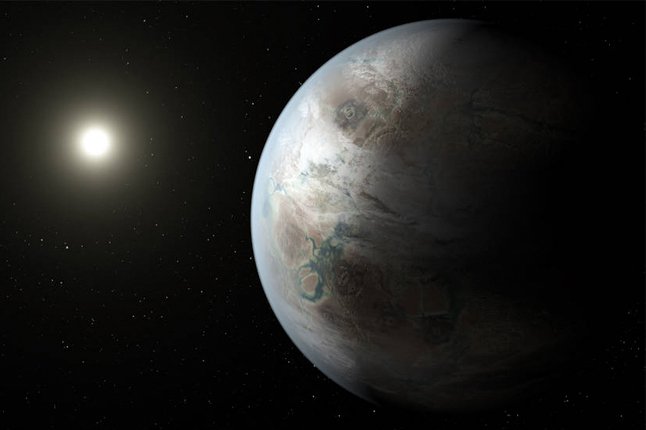1 of 2 | This artist's concept depicts one possible appearance of the planet Kepler-452b, the first near-Earth-size world to be found in the habitable zone of a star that is similar to our sun. The habitable zone is a region around a star where temperatures are right for water -- an essential ingredient for life as we know it -- to pool on the surface. Scientists do not know whether Kepler-452b can support life. What is known about the planet is that it is about 60 percent larger than Earth, placing it in a class of planets dubbed "super-Earths." Photo by NASA Ames/JPL-Caltech/T. Pyle/UPI
WASHINGTON July 23, 2015 -- Scientists have found the most Earth-like exoplanet yet.
On Thursday, NASA confirmed during a teleconference that its Kepler Space Telescope mission has discovered the Earth's bigger, older cousin -- Kepler-452b, a body 1,400 light-years away in the habitable zone -- that is, the region near stars where orbiting planets might have the conditions to support the existence of liquid water.
"There's a new kid on the block that's just moved in next door," said Jon Jenkins, Kepler data analyst lead at NASA's Ames Research Center in Moffett Field, Calif. "If you travel to this planet, the sunshine from its star would be very similar to the sunshine we feel on Earth."
The exoplanet, which scientists nicknamed Earth 2.0, receives 10 percent more energy from its star than our home planet does from the sun. NASA said Kepler-452b orbits its star in a 385-day cycle, just about 20 days longer than the year we experience.
But Jenkins said the exoplanet is about five times as massive as the Earth and has twice the Earth's gravity.
"It is certainly quite challenging at first for human beings to live on," said Jenkins."But over time we might be able to adapt to the condition."
Scientists said people like firefighters and backpackers are already experiencing that feel by carrying heavy equipment. As humans get bigger and stronger over time, it would be like "a workout every day."
While researchers said the exoplanet is likely to have a rocky surface, Jenkins said the experts will dive into the data for further analysis. "We hope it's rocky," he said. "It feels like you are on the top of a roller coaster. You are waiting for the drop."
At the teleconference Thursday, scientists said they confirmed the discovery through reprocessing of original data collected by the Kepler Space Telescope mission from 2009 to 2013.
In 2013, NASA announced the failure of two of Kepler's four gyroscope-like reaction wheels, which are used to precisely point the spacecraft. A year later, NASA repurposed the mission as K2 to continue scientific observations with the Kepler spacecraft in a new two-wheel mode of operation. The spacecraft follows an Earth-trailing heliocentric orbit around the sun with a period of 372.5 days.
"It seems K2 is enjoying having a repetitive thermal environment. It's progressing quite well," scientists said. So far, the Kepler mission has confirmed 1,028 exoplanets and selected more than 4,000 candidates.
The Kepler mission, launched in 2009, is designed to find Earth-like planets in the habitable zone. The telescope's construction and initial operation were managed by NASA's Jet Propulsion Laboratory, with Ball Aerospace responsible for developing the Kepler flight system. The Ames Research Center is responsible for the ground system development.
According to NASA, the Kepler Space Telescope observes the tiny dips in the brightness of a star during a transit -- when a planet crosses in front of it. Once detected, the planet properties can be calculated from time span of transit and how much the brightness of the star drops.
Scientists said the Kepler mission is just one member of the exoplanet science family. Future missions like the Transiting Exoplanet Survey Satellite, which is scheduled to launch in 2017, and the James Webb Space Telescope to be launched in 2018, are in line to discover the nearest rocky exoplanets and determine their composition and atmospheric conditions.
"This is just the beggining, " said Didier Queloz, professor of astrophysics at Cambridge University. "It's a very long journey."















